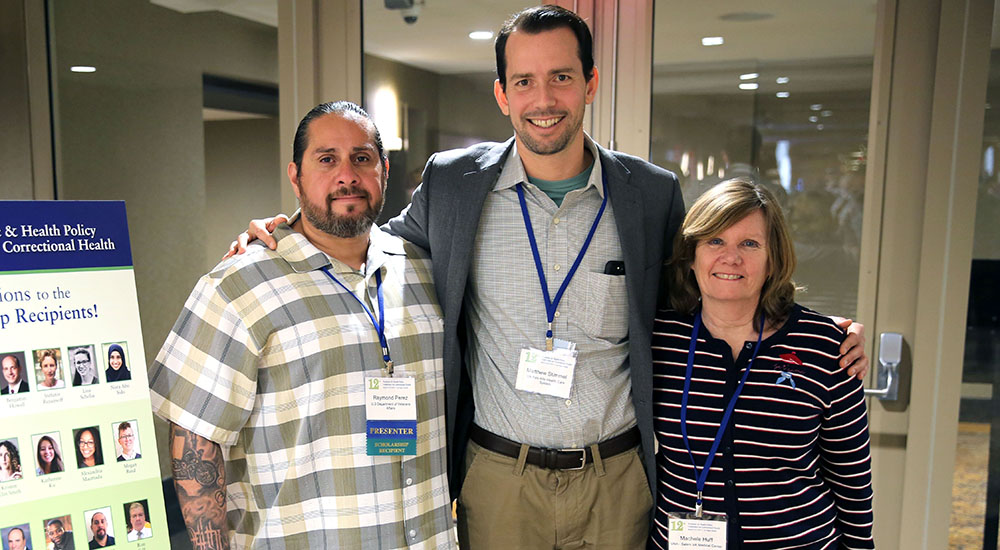VA correctional health conference team members: (L to R) Raymond Perez, Phoenix VA, Dr. Matthew Stimmel, VA Palo Alto, Machele Huff, Salem VAMC
On any given day in the United States, an average of 181,500 Veterans are incarcerated—about seven percent of the prison population, according to the Department of Justice.
Former Army infantryman Raymond Perez was one. “After I got out, I struggled with a number of issues that I was in denial about, and I chose to self-medicate. I dealt with addiction, homelessness and ultimately incarceration,” says Perez.
After his release, Perez was able to get back on his feet thanks to compensated work therapy, a clinical vocational rehabilitation program offered at every VA medical center. Today he is a peer support specialist with the Phoenix VA Health Care System Community Resource and Referral Center. These centers, located across the country, provide Veterans who are homeless and at risk of homelessness with one-stop access to housing, health and mental health care, career development and VA and non-VA benefits.
“What I do is go to different prisons throughout the state of Arizona and I inspire Veterans with hope,” explains Perez. “I let them know, ‘I’ve been there. I’ve been incarcerated. If I can get out of it, you can too.’ We’re sharing our stories and offering different tools for Veterans to succeed once they get released from prison. Each and every one of us has to decide for ourselves when we are ready to make a change. My job is to walk alongside them and reassure them that there is hope.”
Preventing homelessness after incarceration
Justice-involved Veterans are often vulnerable to becoming homeless, notes Jessica Blue-Howells, national coordinator of the Health Care for Re-entry Veterans Program, which is designed to promote success and prevent homelessness among Veterans returning home after incarceration. “Having any kind of criminal justice history—a single arrest or a long-term incarceration in prison—is a huge risk factor,” says Blue-Howells. “Whether it’s access to housing or to maintain housing, it’s difficult to achieve either if, in your credit record, you have a criminal history.”
Veterans with a criminal justice history are also at especially high risk for suicide, according to Blue-Howells. “That is why we try to incorporate mental health and Veterans’ peer support,” she says.
Another VA initiative to help justice-involved Veterans is the Veterans Justice Outreach Program, or VJO, which has three main objectives. The first is to train law enforcement and crisis intervention teams in dealing with Veterans. The second is to establish and work with Veterans treatment courts, an alternative judicial system that helps service members and Veterans avoid incarceration if the crime they are charged with is related to a mental health issue or drug dependency. Finally, VJO identifies and works with incarcerated Veterans to make sure they receive health care and support, whether in county jails or state prisons.
“I think there is a strong push in communities throughout the country to get Veterans the services that they need,” says Dr. Matthew Stimmel, clinical psychologist and Veterans justice outreach specialist at VA Palo Alto Health Care System. “They realize that some of the problems that led them to contact with the justice system are treatable problems and often the result of their service, and not necessarily because they are bad people.”
Veteran focused sessions at national conference
To spread the word among the criminal justice community about the work VA is doing with incarcerated and justice-involved Veterans, VA sent a team, including Perez and Stimmel, to the 2019 Academic & Health Policy Conference on Correctional Health, a national conference sponsored by the Academic Consortium on Criminal Justice Health. There were Veteran-focused sessions on Veterans treatment courts, law enforcement interactions with Veterans, female justice-involved Veterans and improving employment opportunities for Veterans with felonies, among other topics. “This is the first year that there has been a really big content presence around Veteran issues,” says Blue-Howells.
“Reintegration can be difficult, but that’s one of the focuses that we have: trying to get our Veterans stably housed, get them linked to treatment and meet their employment needs,” says Stimmel. “We’re fortunate at VA to have all of those needs met within one organization. It’s an uphill battle, for sure, and we’re doing the best we can to meet the needs of our Veterans.”
About the author: John Archiquette, is a Public Affairs Specialist, at the VA Southern Nevada Healthcare System
Topics in this story
More Stories
Study underscores important role COVID vaccination can have in protecting Veterans from infection and reducing long-term health consequences
Columbia VA’s robotic surgery teams completed their 800th robotic surgery and are on schedule to hit 1,000 by the end of the year.
In a decentralized clinical trial, Veterans can participate from their own homes or local VA instead of having to travel to a research site.






